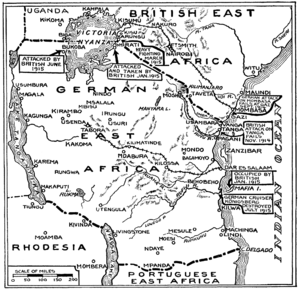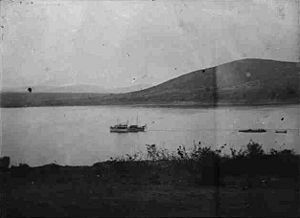Battle for Lake Tanganyika facts for kids
Quick facts for kids Battle for Lake Tanganyika |
|||||||
|---|---|---|---|---|---|---|---|
| Part of the East African Campaign of the First World War | |||||||
 Lake Tanganyika, contested by Britain, Belgium and Germany |
|||||||
|
|||||||
| Belligerents | |||||||
|
|
|
||||||
| Commanders and leaders | |||||||
| Strength | |||||||
| British: 2 steamers 3 armed boats Belgian: 1 steamer 1 armed boat 1 armed barge 1 whaler 4 aircraft unknown shore batteries |
2 steamers 1 ferry unknown dhows 1 fort unknown shore batteries |
||||||
| Casualties and losses | |||||||
| British: No human losses 1 armed boat damaged Belgian: 1 steamer sunk |
~12 killed 2 wounded 32 captured 1 steamer sunk 1 ferry scuttled 1 steamer captured |
||||||
|
|||||||
The Battle for Lake Tanganyika was a series of exciting naval fights. They happened during the First World War between December 1915 and July 1916. British and Belgian forces battled against German ships on Lake Tanganyika in Africa.
At the start of the war, German ships controlled the lake. This was a big problem for the Allies (Britain and Belgium). The British decided to send two small, fast motor boats, HMS Mimi and Toutou. These boats had an amazing journey, traveling all the way from Britain to Africa. They went by ship, train, river, and even dragged through the jungle!
Once on the lake, these small boats, led by Lieutenant-Commander Geoffrey Spicer-Simson, surprised the Germans. They attacked and defeated two German ships. One German ship was captured and renamed HMS Fifi. Another was sunk. The largest German ship, Graf von Götzen, was later sunk by its own crew. By July 1916, the British and Belgians had taken control of Lake Tanganyika.
Why the Battle Happened
Control of Lake Tanganyika
Lake Tanganyika is a very long lake in Africa. It lies between what was then the Belgian Congo (now Congo) and German East Africa (now Tanzania). When World War I began, Germany had two warships on the lake: Hedwig von Wissmann and Kingani.
These German ships quickly took control of the lake. They sank a Belgian ship and a British ship. This meant the Germans could move troops and supplies easily across the lake. They could also attack British and Belgian areas. This made it hard for the Allies to fight the Germans on land.
A Bold Plan to Fight Back
In April 1915, a hunter named John R. Lee came up with a daring idea. He had seen the German ships on Lake Tanganyika. He also knew the Germans were building a new, much bigger ship called Graf von Götzen. This ship was huge and could carry many soldiers. It would give Germany even more control.
Lee suggested sending small, fast motor gunboats to Africa. These boats would be light enough to be carried overland. They could be launched quickly onto the lake. This way, they could surprise the Germans and fight their bigger ships. The British Navy liked the plan. They chose Lieutenant-Commander Geoffrey Spicer-Simson to lead the mission.
Spicer-Simson was a bit unusual, but he was chosen because he had experience in Africa. He gathered 27 men and two motor boats. These boats were originally made for the Greek government.
The Amazing Journey of Mimi and Toutou
The two British motor boats were 40 feet long. Spicer-Simson named them Mimi and Toutou, which meant "Miaow" and "Bow-wow" in French. The boats were fitted with machine guns and a small cannon. They were tested on the River Thames in England. During a test, the cannon flew off the deck because it wasn't bolted down!
The boats and their equipment were loaded onto a ship on June 15. Their journey was over 10,000 miles long! First, they sailed for 17 days to South Africa. From there, they traveled by train through Bulawayo to Lubumbashi.
After the train, they were pulled 146 miles through the African bush. Teams of oxen and steam tractors did the hard work. Then, they went by river steamer down the Lualaba River. Finally, a small railway took them close to Lake Tanganyika. They arrived in October, ready to fight the Germans.
German and Belgian Preparations
The Germans also prepared their forces on the lake. They used sailors from other sunken German ships. Their main ships were Kingani, Hedwig von Wissmann, and the new, powerful Graf von Götzen. Götzen was armed with a large 105mm naval gun.
The Belgians had fewer ships. They hoped to assemble a large steamer called Baron Dhanis. They also had a small armed barge and a motor boat. The Belgians also used floatplanes (planes that can land on water) to watch German positions and bomb them.
The Battle Begins
German Spy Mission
The German commander, Captain Gustav Zimmer, knew something was happening. He sent Lieutenant Job Rosenthal on Kingani to scout the Belgian port of Lukuga. Rosenthal saw a new harbor being built. He also saw the British flag and realized the British were there with their boats, Mimi and Toutou.
Rosenthal tried to get back to his ship but was captured by a Belgian patrol. He managed to send a secret message to Zimmer, warning him about the British boats. But the message took months to arrive.
Mimi and Toutou are Launched
The new harbor at Kalemie was ready by mid-December. On December 22, Toutou was launched onto Lake Tanganyika. Mimi followed the next day. The boats were fueled and their guns were fitted.
On December 26, the German ship Kingani approached Kalemie. The German officer in charge, Sub-Lieutenant Junge, was looking for information. At 6:00 AM, as Spicer-Simson was holding morning prayers, Kingani was spotted.
Kingani is Captured
Mimi and Toutou quickly left the harbor to chase Kingani. Junge was surprised to see two motor boats flying the British flag. He tried to speed away. Kingani's gun could only fire forward, but the British boats were faster and could move around.
After just 11 minutes of fighting, Kingani was hit. The shell went through her gun shield, killing Junge and two other sailors. After more hits, the German crew surrendered. The British captured Kingani and renamed her HMS Fifi. Spicer-Simson said Fifi meant "tweet-tweet" in French.
The British were very impressed. Spicer-Simson was promoted. Even King George V sent a message praising the expedition's "wonderful work."
Hedwig is Sunk
In mid-January, the German ship Hedwig von Wissmann came to Lukuga to find out what happened to Kingani. By now, the British had also repaired a Belgian ship, Delcommune, and renamed her Vengeur.
On February 8, Hedwig was spotted. The combined British and Belgian fleet set out to meet her. This included Mimi, Fifi, and a Belgian boat. The German commander, Odebrecht, saw them. He first thought they were Belgian ships, but then saw the British flags.
The ships began to fight. Fifi fired her 12-pounder gun, but the recoil stopped her. Mimi sped past, firing her smaller gun. The ships circled, trying to hit each other. Finally, Fifi got closer. With her second-to-last shell, Fifi hit Hedwig's hull, causing flooding. Her last shell hit the engine room, blowing up the boiler.
Fires spread, and Odebrecht ordered his crew to abandon ship. He also set explosives to sink the ship. Seven German sailors died, but 20 survivors were captured by the British. The British also captured a large German naval flag, the first taken in the war.
Götzen is Scuttled
The next day, the large German ship Götzen appeared, looking for Hedwig. Spicer-Simson decided not to attack. He then left to find another boat to challenge Götzen. He found a steel boat called St George, had it taken apart, moved to the lake, and put back together.
By the time he returned in May, the Germans were losing ground. The Belgians were about to capture the German base at Kigoma. The British forces on the lake helped the land operations. However, Spicer-Simson made a mistake at Bismarckburg. He thought a fort there had real guns, but they were just wooden dummies! This allowed German soldiers to escape.
Meanwhile, the British gave the Belgians four floatplanes. These planes bombed Götzen at Kigoma. What they didn't know was that the Germans had already removed most of Götzen's real guns to use on land. They put wooden fake guns on the ship to trick the Allies.
Kigoma fell to the Belgians on July 28. But Götzen was already gone. The Germans had sailed her to a bay south of Kigoma. They carefully filled her with sand and sank her on July 26. They greased her engines well, hoping to use her again someday.
What Happened Next
By mid-1916, the British and Belgians controlled Lake Tanganyika. The war in Africa continued for two more years. Spicer-Simson was honored for his bravery. However, he was also told off for being difficult with his Belgian allies.
The story of the Battle for Lake Tanganyika became very famous. It even inspired a book called The African Queen, which was later made into a movie.
The most amazing part of the story is that Graf von Götzen still exists! The Belgians raised her from the lake, but she sank again in a storm. The British raised her again in 1921. They found her engines were so well preserved by the grease that she was easy to repair. She returned to service in 1927 as Liemba, and she still sails on Lake Tanganyika today!
Images for kids














